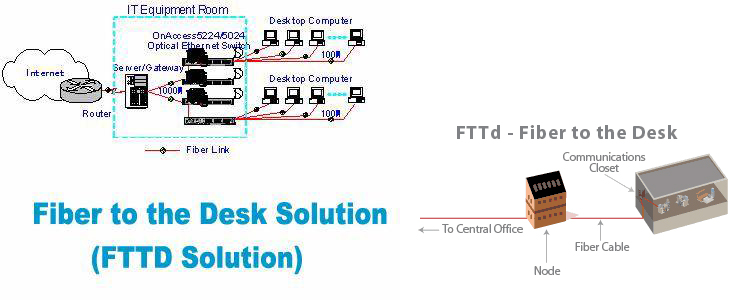Fibre to the ‘x’ (FTTX) is a generic term for any broadband network architecture using optical fiber to replace all or part of the usual metal local loop used for last-mile telecommunications. Configurations of this kind of fiber deployment can range from FTTN (fiber to the neighbourhood) to FTTD (fiber to the desk).

With a steady rise in the importance of corporate data networks within the business environment, these have become a basic infrastructure for any company. Larger the company, higher are the number of employees that would require connectivity, internally within the organisation as well as externally. FTTD indicates applications where fiber optic connections are distributed from the central office to individual work stations or computers inside a structure, dwelling, or building. It is a high-bandwidth solution, which expands the traditional fiber backbone system by running fibre directly to desktops. It is basically a horizontal wiring option that pushes the available bandwidth beyond 10G and a different approach to the installation of a corporate network using fibre optics.
Why Fibre?
Fibre optic cabling is highly reliable as well as expandable. In today’s computer-driven world, network downtime is highly unacceptable. Hence reliability is the key aspect. Also, since it’s difficult to predict future requirements, fibre can be expanded as required without compromising on functionality and network speeds, thus providing longer length support and minimizing wiring costs. Another advantage of fibre that makes it an easy to install option is its bend radius. Other well known benefits include lower attenuation, decreased cross-talk issues, immunity from electromagnetic interference, lighter weight and support for applications from 10 Mbps to 10 Gbps.
Today’s Scenario
Due to the increase of high-definition videos and cloud services, ultra-broadband access is becoming more popular in the development of broadband networks. The existing industry FTTx solutions have proved incapable of resolving the problems in FTTB(fiber-to-the-building, -business, or -basement) and FTTH(fiber-to-the-home) scenarios. In FTTB, bandwidth is limited, and site locations are restricted by power supply and grounding issues. FTTH construction presents difficulties such as drop fiber installation, long construction times, and large initial investments. Telecom operators are eager to overcome these difficulties by reusing the existing copper resources at home while providing a bandwidth as large as that for fiber access.
Huawei’s FTTD Solution
This fibre to the door (FTTD) solution provides ultra broadband access as fast as 100 Mbit/s to 1000 Mbit/s by reusing the existing twisted pairs or coaxial cables through an innovation of line technologies, project implementation technologies, service provisioning and OAM technologies claims Huawei. It goes on to further claim that the solution also overcomes the difficulties of the traditional fibre to the home (FTTH) or fibre to the building (FTTB) scenarios, such as drop fibre installation, slow deployment, large investments, and effectively provides operators with broadband access.
This FTTD solution inherits the advantages of the FTTH and FTTB solutions to meet the challenges of ultra-broadband and drop fiber installation believes Huawei. The access equipment is deployed at an outdoor position nearest to the user, such as in the corridor or the telecom riser. The existing twisted pairs, coaxial cables, and Ethernet network cables are reused to resolve the drop fiber installation issue. In addition, VDSL2, Vectoring, and Giga DSL technologies are used to provide ultra-broadband as fast as 100 Mbit/s to 1000 Mbit/s.
The FTTD solution uses new methods such as reverse power supply, free grounding, and free configuration to support the plug-and-play feature and remove the need to perform configurations on site. For service provisioning and OAM, the FTTH OSS system is reused and equipment matching becomes easy.
Huawei provides FTTx ultra-broadband access for home users, mobile hotspots, and small and medium-sized enterprises through the SingleFAN solution. “Huawei is dedicated to continuous customer-centric innovation. We believe that the FTTD solution can help our customers resolve difficulties in deploying FTTH networks. Relying on the advantages of the FTTD solution such as ultra-broadband access through any medium, simple deployment, and remote management, operators can stay ahead of the fierce market competition and achieve business success,” said You Yiyong, president, Access Network Product Line at Huawei.
As a new component of Huawei’s SingleFAN FTTx solution, the FTTD solution has been tested on the live networks of many operators worldwide and is to be put into trial commercial use in Europe and the Middle East.
Considering the high amount of development in broadband services, these type of cables would be one of the most aggressively developing sectors in the years to come.










